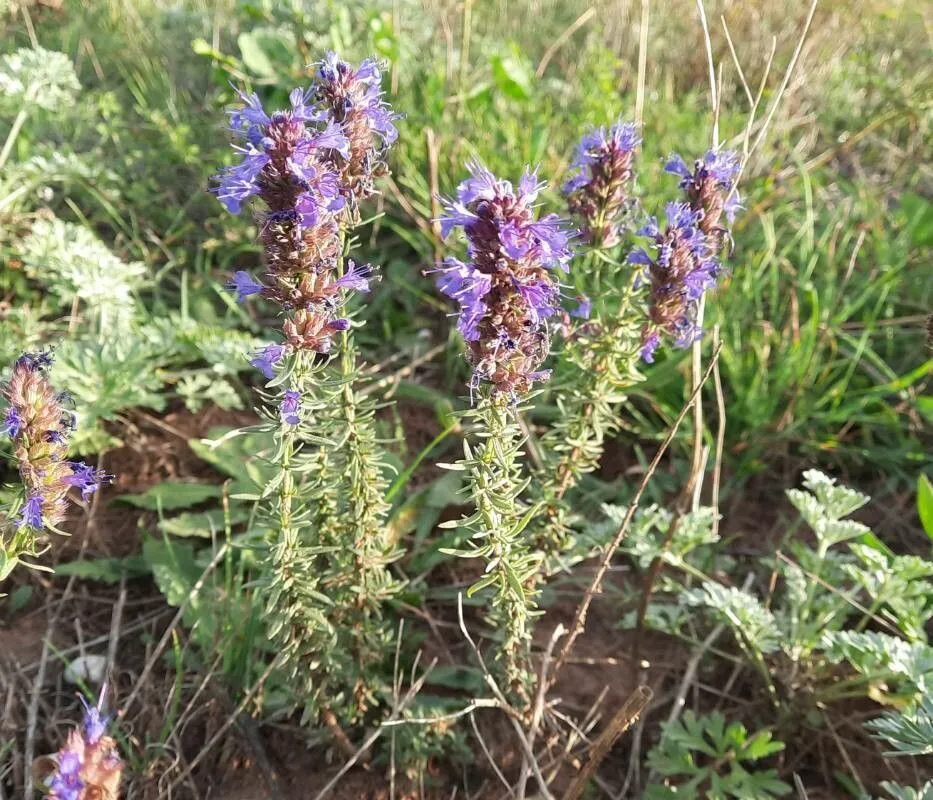
Author: L.
Bibliography: Sp. Pl.: 569 (1753)
Year: 1753
Status: accepted
Rank: species
Genus: Hyssopus
Vegetable: False
Observations: Europe, Medit. to Iran
Hyssop, scientifically known as Hyssopus officinalis, is a versatile and aromatic plant revered for its culinary, medicinal, and ornamental qualities. Belonging to the Lamiaceae family, this hardy perennial herb has been valued since ancient times and continues to hold a significant place in modern gardens and natural medicine cabinets.
Native to regions spanning from Europe to the Mediterranean and extending to Iran, hyssop thrives in sunny, well-drained soils. Its striking blue, pink, or white flowers bloom in dense clusters along slender, woody stems and can reach a height of 30 to 60 centimeters. The lance-shaped, dark green leaves are rich in essential oils, which contribute to hyssop’s strong, slightly minty aroma and bitter taste.
Historically, hyssop has been employed for its healing properties, with records dating back to ancient Greek and Roman times. It was traditionally used for treating respiratory ailments, such as coughs and bronchitis, thanks to its expectorant qualities. Moreover, its antimicrobial and anti-inflammatory properties made it a common remedy for wounds and skin irritations.
In the culinary world, hyssop leaves can be used sparingly to flavor salads, soups, and stews, where its pungent taste imparts a unique zest. The plant’s nectar-rich flowers are also attractive to bees, making it a popular inclusion in pollinator-friendly gardens.
Cultivating hyssop is relatively straightforward. It prefers full sun and well-drained soil but can adapt to various conditions, making it a resilient choice for herb gardens. Once established, hyssop requires minimal maintenance, with occasional pruning to encourage bushier growth and to prevent it from becoming woody.
In summary, Hyssopus officinalis is a remarkable herb with a rich history and a multitude of uses. Whether employed in medicine, cooking, or as a decorative plant, hyssop remains a cherished and invaluable member of the plant kingdom.
Deu: arznei-ysop, echter ysop, gewöhnlicher ysop, ysop
Eng: hyssop, common hyssop, garden hyssop
Pol: hyzop lekarski
Dan: isop, ægte isop
Lit: vasitinis yzopas
Por: alfazema-de-caboclo, hissopo
Est: harilik iisop
Spa: hisopo
Fra: hissope, hysope officinale, hysope
Swe: iisoppi, isop
Fin: iisoppi
Nno: isop
Nob: isop
Hun: kerti izsóp
Ces: yzop lékařský
Nld: hyssop
Cym: hysop, isob, isobl, isop, ysop
En: Hyssop, Common hyssop, Garden hyssop
Af: Hisop
Ar: زوفا طبية
Az: Dərman çödükotu
Eu: Isipu-belar
Be: Ісоп лекавы
Bg: Лечебен исоп
Ca: Hisop
Zh: Shen xiang cao, 柳薄荷, 海索草, 牛膝草, 神香草
Hr: Izop
Cs: Yzop lékařský
Da: Ægte Isop, Isop
Nl: Hyssop, Hysop, Hijsoop
Eo: Oficina hisopo
Et: Harilik iisop
Fi: Iisoppi, Rohtoiisoppi
Fr: Hysope officinale, Hysope, Hissope, Herbe sacrée
De: Ysop, Echter Ysop, Arznei-Ysop, Gewöhnlicher Ysop
El: Ύσσωπος ο φαρμακευτικός
Hu: Kerti izsóp
Ga: Íosóip
It: Issopo
Lt: Vaistinis isopas, Vasitinis yzopas
Lb: Ysop
Mk: Изоп
No: Isop
Nb: Isop
Nn: Isop
Fa: زوفا
Pl: Hyzop, Józefek, Hyzop lekarski
Pt: Hissopo, Alfazema-de-caboclo
Ru: Issop obyknovennyj, Иссоп лекарственный
Sr: Милодух
Sk: Yzop lekársky
Es: Hisopo, Hisopo común
Sv: Isop, Iisoppi
Zh-tw: 神香草
Th: หุสบ
Tr: Zufa otu
Uk: Гісоп лікарський
Ur: زوفا
Cy: Isop, Hysop, Isob, Isobl, Ysop
Taken Oct 4, 2022 by Joey F (cc-by-sa)
Taken Oct 17, 2021 by Fabrice Rubio (cc-by-sa)
Taken Mar 23, 2015 by Tela Botanica − Liliane Roubaudi (cc-by-sa)
Taken Mar 23, 2015 by Tela Botanica − Liliane Roubaudi (cc-by-sa)
Taken Mar 23, 2015 by Tela Botanica − Liliane Roubaudi (cc-by-sa)
Taken Apr 9, 2021 by Juli Ane (cc-by-sa)
Taken Oct 29, 2020 by flo badass (cc-by-sa)
Taken Sep 6, 2021 by Francois Mansour (cc-by-sa)
Taken Dec 8, 2021 by xada (cc-by-sa)
Taken Jun 29, 2019 by Hornef Sandra (cc-by-sa)
Taken Sep 6, 2021 by Francois Mansour (cc-by-sa)
Taken Nov 13, 2022 by M Mary (cc-by-sa)
Taken Aug 31, 2017 by Mercé Camarasa (cc-by-sa)
Taken Jun 6, 2020 by Kadanga KADANGA (cc-by-sa)
Taken Aug 1, 2013 by Tela Botanica − Jean-Louis CHEYPE (cc-by-sa)
Taken Jul 24, 2021 by Manuëlle (cc-by-sa)
Taken Mar 23, 2015 by Tela Botanica − Liliane Roubaudi (cc-by-sa)
Taken Mar 23, 2015 by Tela Botanica − Liliane Roubaudi (cc-by-sa)
Taken Mar 23, 2015 by Tela Botanica − Liliane Roubaudi (cc-by-sa)
Taken Nov 6, 2021 by Irene Ruggieri (cc-by-sa)
Taken Oct 20, 2016 by Tela Botanica − Martine MARTHOURET ROBERT (cc-by-sa)
Taken Aug 15, 2016 by Tela Botanica − Jm LAUNAY (cc-by-sa)
Taken Jun 7, 1992 by Tela Botanica − Liliane ROUBAUDI (cc-by-sa)
Taken Oct 15, 2022 by Miguel A. C. (cc-by-sa)
Taken Jun 7, 1992 by Tela Botanica − Liliane ROUBAUDI (cc-by-sa)
© copyright of the Board of Trustees of the Royal Botanic Gardens, Kew.
© copyright of the Board of Trustees of the Royal Botanic Gardens, Kew.
© copyright of the Board of Trustees of the Royal Botanic Gardens, Kew.
Taken May 4, 2020 by Rimsky Vadim (cc-by-sa)
Taken Jul 16, 2021 by Jesus José Onaldo de Jesus (cc-by-sa)
Taken Jul 8, 2019 by Druid Green (cc-by-sa)
Taken Aug 15, 2016 by Tela Botanica − Jm LAUNAY (cc-by-sa)
Taken Oct 4, 2022 by Joey F (cc-by-sa)
Growth habit: Subshrub, Forb/herb
Bloom months: [‘jul’, ‘aug’, ‘sep’]
Family: Myrtaceae Author: (F.Muell.) K.D.Hill & L.A.S.Johnson Bibliography: Telopea 6: 402 (1995) Year: 1995 Status:…
Family: Rubiaceae Author: Pierre ex A.Froehner Bibliography: Notizbl. Bot. Gart. Berlin-Dahlem 1: 237 (1897) Year:…
Family: Sapindaceae Author: Koidz. Bibliography: J. Coll. Sci. Imp. Univ. Tokyo 32(1): 38 (1911) Year:…
Family: Asteraceae Author: A.Gray Bibliography: Pacif. Railr. Rep.: 107 (1857) Year: 1857 Status: accepted Rank:…
Family: Fabaceae Author: Medik. Bibliography: Vorles. Churpfälz. Phys.-Ökon. Ges. 2: 398 (1787) Year: 1787 Status:…
Family: Aspleniaceae Author: (Cav.) Alston Bibliography: Bull. Misc. Inform. Kew 1932: 309 (1932) Year: 1932…